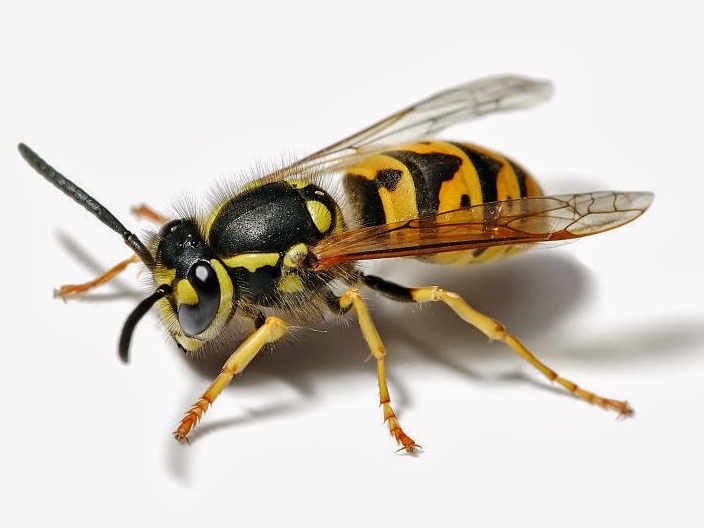In a mixed conifer forest in the mid-elevations of the Sierra Nevada Mountains in California, a yellow jacket wasp hovers an inch above the forest floor, fanning the pine needles with her downwash, shifting rhythmically back and forth a few times and then skimming to a new spot, checking things out. She is a queen. It is spring and she has just emerged from hibernation. She is stiff from her long, cold sleep, but her flight muscles are starting to warm up. She circles the trunk of a large ponderosa pine and returns to checking out the pine duff, using all her senses to detect what’s beneath. She has a job to do: she needs to find a nest site.
She’s fond of abandoned rodent burrows, but a number of things will work. She settles on an old ground squirrel burrow, its entrance obscured by fragrant pine needles.
All alone, she goes to work. She does the small amount of excavating that needs to be done to reopen the entrance, and then builds a small paper comb hanging from the ceiling, just a few dozen cells, and she lays eggs in them. As she waits for them to hatch, she goes out on forays into the woods, learning the area, and fortifying herself with nectar from some wildflowers.
When the larvae hatch, she feeds and nurtures them, going out on hunting trips and feeding them noshed-up insects she has killed. They mature quickly into adult wasps. They are sterile females—workers—but she can create fertile males also, any time she wants, egg by egg. The new worker wasps hang the next rack of cells beneath the first, and it is bigger, and she lays more eggs. She has a crew now, and the crew is helping her create more crew. The hive is bootstrapping itself, from almost nothing. As the combs grow and the workforce strengthens, she begins staying inside, focusing on reproduction, and staying safe. The workers around her are capable and armed, and they will stop at nothing to defend her.
The workers range out across the landscape to find food for the growing hive. They are energetic, inquisitive and aggressive. They have a lot of mouths to feed, and they don’t go in for subtlety. They are predators, and they launch a brutal and resolute assault on the local insect population, quickly asserting balance into the explosive springtime hatches of flying and crawling creatures.
But they do not eat the meat themselves. In fact, they don’t eat meat at all. They only eat liquidy sweet stuff, like nectar, and now and then some fruit. What they do with the insects they’ve killed is to feed them to the larvae, who need the protein. The larvae, in turn, secrete a sweet liquid that keeps the workers fed. There is no selfishness in this hive—you get fed by giving. It’s a behavior called trophallaxis, and it’s pretty common in social insects.
As the colony grows, the workers start to fly farther, trying to find enough meat to feed the booming larvae. When the catch of insects starts to get thin, their scavenging behavior kicks in, and they scour the picnic areas, getting waved and slapped at by slow and lumbering hands.
It’s late summer by now, and the colony is approaching 2,000 wasps. It is bustling and humming, and their numbers in the woods and the picnic grounds are getting intense. As the queen starts to wind down her egg-laying, and the larvae numbers begin to taper, an interesting mathematical problem emerges. There are no longer enough larvae to feed all the workers. The workers go out and scour the landscape anew, but now they’re not trying to feed the larvae, they’re trying to feed themselves. Again the picnic area works for them, but this time they’re not looking for meat for the larvae, they’re looking for sweet stuff for themselves. They’re not after the hot dogs, they’re after the soda pop.
* * * *
Early fall. There is a chill in the air, and these creatures do not handle cold well. Already, some of the workers are dropping, or not returning from their foraging runs. When the first serious cold hits, the entire colony will perish. The workers, the handful of fertile males, even the queen who founded the hive, everybody dies—but there is a new queen. Maybe more than one. She has been carefully nurtured and generously fed. She is young, strong and she has reserves. She has spiraled up on the mating flights with the males, and had her moments of rapture in the sky. And now, she flies off, all alone, leaving behind her the collapsing colony. A few weeks from now it will be a scatter of dead bodies and some crumbling paper combs. It will not be re-used.
She looks for a place to hibernate. She crawls into a deep crevice in a western black oak tree. She nestles carefully into her space, and there, with the existence of an entire colony resting on her survival, she shuts herself down and waits for spring.

